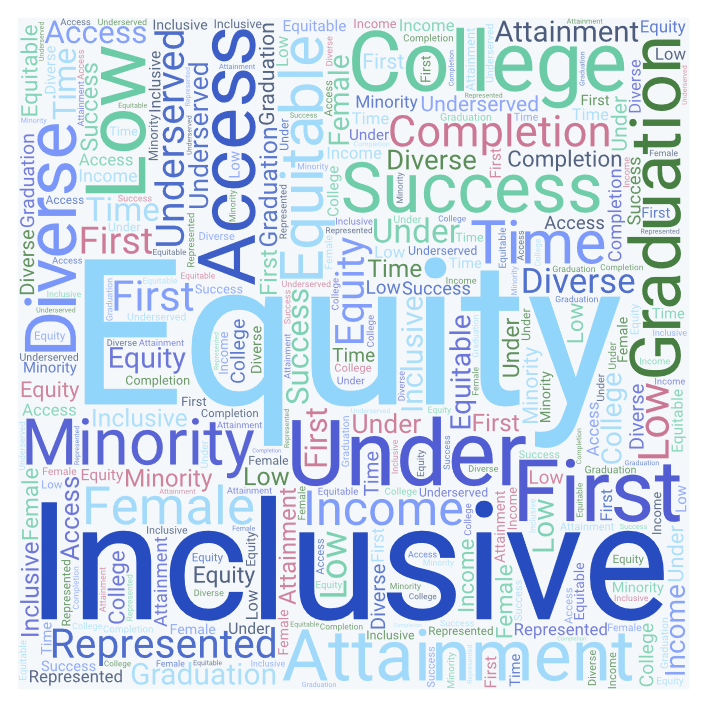
Today’s post from Janelle Elias with the WCET Steering Committee working group on Diversity, Equity, and Inclusion reviews her research on how WCET member institutions are addressing equity work in strategic plans. This post continues the series started earlier this month on “Enabling Difference.” WCET leadership will continue the series throughout the month of August 2021! Thank you to Janelle for conducting this study and presenting the results to us today!
Enjoy the read and enjoy your day,
Lindsey Downs, WCET
The strategic planning process is a critical opportunity for institutions to reflect on current-state performance and outcomes, engage internal and external constituent groups, identify areas of continuous improvement, and envision roadmaps to future success. Governing and accrediting organizations expect institutions to use qualitative and quantitative data – in alignment with organizational vision, mission, and values – to drive planning and inform resource allocation. In an ideal state, strategic goals, objectives, initiatives, metrics, and targets will be explicitly defined for public consumption. Taking this lens into account, WCET was curious to understand how its member institutions are addressing the work of Diversity, Equity, and Inclusion (DEI) within their publicly documented strategic plans and initiatives in an effort to identify trends and best practices.
As of May 2021, WCET’s membership network was comprised of 395 organizations from the following sector types: Corporation (N=22); Governing/Coordinating Agency (N=36); Non-profit organization (N=29); Private, independent institution (N=75); Public, 2-year institution (N=68); and Public, 4-year institution (N=165). We selected a 10% random, stratified sampling of 41 strategic plans from the WCET membership for qualitative analysis. Member organizations from 24 states were randomly selected.
Five organizations out of the 41 selected did not have strategic plan documents nor strategic plan web pages published, bringing the total sample size down to 36 plans. One plan was expired but included in the analysis because it was still published. The two corporate organizations did not publish strategic plans.

Institutions focused on increasing access for specific student populations, using a wide variety of language to describe these target populations, such as:
In addition to setting access goals as a means of improving diversity, equity and inclusion, some institutions also focused on attainment goals. 25 institutions in this sample (nearly 70%) had explicit “attainment/completion/graduation” goals; however, only 17 of these had published measurable targets. Part of the challenge here is that institutions are measuring student success in vastly different ways. In general, institutions focused on course completion, degree attainment, transfer rates, and employment rates.
After a summer spent with some of your strategic planning documents, we observed a spectrum of approaches to diversity, equity, and inclusion within the WCET membership:
A study of the intentional language used in higher education strategic planning documents, as well as the lack of consistent language or the absence of DEI language across sector types and locations, may illustrate early stages of awareness and change in the industry. One thing is clear – planning to plan is a critical part of centering DEI work in the strategic planning process.
Strategic plans can be powerful documents in an institution’s efforts to improve diversity, equity, and inclusion (DEI). When developing or executing a strategic plan, institutions should consider the following:

At the conclusion of this project, I reviewed my institution’s strategic plan through this renewed lens.
Our strategic plan and culture statements (mission, vision, values, and practices) make it explicitly clear that diversity, equity, inclusion, and belonging are top priorities for Rio Salado College and the driving force behind all the work we do. We also define success by an individual student’s goal attainment. These concepts are difficult to measure, yet we work hard to understand them at our institution.
There is deep, internal culture work that must occur before anyone can expect the results of this strategic work to impact equitable outcomes. Peter Drucker warned us that “culture eats strategy for breakfast” so it is encouraging to see so many institutions of higher education focus on fostering cultures that promote DEI. Through this strategic work, governance, policies, practices, curriculum, and outcomes can be improved.
Elias brings her lens as a first-generation student, with decades of higher education online education experience, and a keen understanding of how to leverage data to innovate student-centric solutions. Elias holds expertise in institutional effectiveness, change leadership, and systems development.